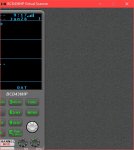Thanks, I looked into it. Basically websocket and jQuery $.get does the same thing. Communications using HTTP over TCP. I think using jQuery uses less overhead and less expensive calls plus users shouldn't have to deal with installing node.js.
I'm not sure what you mean by "view only". It has remote control capability. If you want to save time sniffing, just right click on the web page and click on view source. The full html and javascript text will show in your text editor.
websockets use *way* overhead than HTTP GET calls (I write web APIs for a living for Stringify, an IoT automation platform)... Mostly because it's all push - if the frequency on your scanner didn't change for the past hour, then there is near zero traffic (apart from an occasional keep-alive) between browser and server! This gets even more significant if you introduce SSL (I'm reverse proxying my ProScan instance over SSL to keep..well, anybody from seeing my traffic). Each HTTP GET requires SSL/TLS negotiation.
I understand it has remote capability. I was talking about sniffing traffic between the 'server' and the scanner itself -
the UDP traffic.
I'm suggesting that ProScan itself could be more lightweight and extensible if, for instance, the Windows app was speaking the same APIs as the Web app. Perhaps you already have most of this done via abstractions in your Windows app source.
I'm not necessarily suggesting that people install node, but it would be somewhat trivial to offer a Raspberry Pi "ProScan server in a box" image. Someone can buy a $50 pi kit, image the SD card with the ProScan image, and be up and running immediately. It could automatically search to see if you have a scanner plugged into its USB port *and* scan your local LAN for the 536HP on Wifi
I know this isn't likely to happen, and I've already got more projects than I know what to do with, but just some thoughts/ideas.
I think the app is amazing, btw. I bought it before my scanner even arrived after seeing what it could do. I wish there was a Mac version.


